Colin Robertson's Blog, page 3
August 4, 2016
Can Coffee Make You a Genius? A Scientific Answer
Originally posted for Hustle & Grind.
If you, with mind untroubled,
Would flourish, day-by-day,
Let each day of the seven
Find coffee on your tray.
It will your frame preserve from every malady
Its virtues drive afar la! la!
Migraine and dread catarrh – ha! ha!
Dull cold and lethargy. [1]
Audiences were appalled in 1732 when Johan Sebastian Bach created the “Coffee Cantata” as a satirical protest of Germany’s demonization of his favorite beverage.
At the time, coffee was villainized just as much as many illegal drugs today. But Bach loved the drink so much that he was willing to explore an entirely new genre–humor–and begin protesting through his music.
And he was not alone.
Coffee has been the drink of choice of some of the greatest geniuses throughout history. But these geniuses didn't just drink coffee, they were obsessive about it.
Beethoven famously counted every single one of the 60 beans in his morning coffee. [2]
Benjamin Franklin not only hung out in coffee shops before they were cool, but he was always sure to have extra coffee supplies while traveling at sea–believing it completely mad to rely on the captain to bring enough. [3]
Yet, none of these men even come close to the daily totals of Teddy Roosevelt, who drank an entire gallon, or Voltaire–who drank 40 to 50 cups! [4]
There are countless more examples: Jerry Seinfeld, David Lynch, and Ralph Waldo Emerson just to name a few.
But is it the coffee that leads to genius? Or something else?
DOES COFFEE LEAD TO GENIUS?
It started with the necessity.
I was in my freshman year of college, and there just weren't enough hours in the day. So I needed to suck it up, drink the bitter tasting beverage I never liked (except in Frappuccino form), and study for my exams.
That's when my love affair with coffee began.
Hardly a day has gone by since then without a cup in the morning, and I've slowly increased my total to 6 per day. Hardly Voltaire numbers, but it's safe to say it's above the average.
As I was slowly increasing my total cups per day, I noticed something else–my willpower, accomplishments, and success in life also increased!
But what role did the coffee play in this success?
For that matter, what role did it play in the success of Beethoven, Benjamin Franklin, or Teddy Roosevelt?
To answer these questions, let's break down how coffee actually works.
HOW DOES COFFEE WORK?
The active ingredient in coffee is caffeine, which is present in many other foods and beverages from chocolate to Red Bull.
When the brain uses energy to perform tasks, it creates a byproduct called adenosine. Adenosine acts like "lactic acid" in the brain and makes you feel tired. Caffeine blocks the effects of adenosine, making you feel more awake.
But does it actually improve performance?
Unfortunately, the answer is not very clear. the clear studies on coffee show that if you have been a coffee drinker for years, your performance is now practically dependent on drinking coffee.
Although caffeine is not particularly addictive–it doesn't cause cravings or illness, just a headache–daily coffee drinkers will require caffeine in order to perform at their best.
[5]
This explains why the geniuses listed above were so meticulous about their coffee.
Beethoven was obsessive about counting his coffee beans because if he had fewer than 60, his creativity and skill as a composer would have suffered.
Interestingly, if you're not a coffee drinker, trying to recover from a poor sleep by drinking a huge pot of coffee in the morning actually won't help nearly as much as it would a regular coffee drinker.
But you can take solace in the fact that despite spending hundreds or thousands of dollars every year on coffee, studies have found only a slight improvement in performance amongst daily drinkers. [5]
So why, then, have all of these great thinkers throughout history been so obsessive about their coffee?
THE FUEL, NOT THE SPARK
Before my love affair with coffee began, I had no real need for it.
I didn't know what I wanted to do with my life yet. I wasn't a great student, and I had no real motivation to stay up late studying. So even if I drank 40-50 cups per day like Voltaire, I wouldn't have anything to use that energy boost on.
However, once I started working towards my purpose in life, that's when coffee became a powerful ally.
I used it to stay up late, I used it to wake up early. I used it to increase my afternoon focus and to summon the energy to go to networking events.
Coffee was the fuel of my purpose, not the creator of it.
I cannot say for sure, but I believe each of these geniuses used coffee the same way. It wasn't the coffee itself that made them geniuses, but it was a powerful tool to help them along the way.
This is why studies have only found a slight improvement in cognitive performance amongst regular coffee drinkers. Most people use coffee as a tool to get through the day, not to work through the night.
It's not the tool that makes a difference, it's why you're using it.
START WITH WHY
So often we read about a great strategy to lose weight, get a promotion, run a successful business, etc. When we see the strategy in action, we immediately credit it for the success.
In reality, though, most success tools, strategies, and resources are just like coffee. They can help you reach a goal, but only after you gain a deep understanding of what you want to achieve and why you want to achieve it.
Without a genuine, inspiring purpose that you truly believe in, you can follow the success habits of great people all you want–but you'll likely end up in a never-ending loop of frustration as you fail with one strategy after the next.
CONCLUSION
Several of history's greatest minds were avid coffee drinkers–even drinking as many as 50 cups per day! Some may look at these people and conclude that coffee will undoubtedly lead to success.
However, when you take a closer look at the reason why these geniuses drank so much coffee, you'll see that it was merely a tool used to help achieve success–rather than the cause of it.
Today, you can learn about nearly all of the tools, strategies, and resources used by successful people. These may explain how people can reach success, but they don't explain why they became successful.
There are many paths that lead to success. So before you commit to one, make sure you gain a deep understanding of what you want to achieve and why you want to achieve it. Then decide whether coffee will help you along the way.
July 27, 2016
A Simple Formula to Discover Your Passion, Talent, and Value
"There are two types of people in this world: hedgehogs and foxes." w rote Isaiah Berlin in his famous essay.
The fox knows a great many things.
He is cunning and smart. He is fast and sneaky. He is always in search of new strategies to beat the hedgehog and win his share of the forest.
The hedgehog, on the other hand, knows one big thing.
He is simple. He uses only one strategy but executes it to perfection. Whatever the fox tries, the hedgehog defends himself with what he knows how to do best.
So when they face each other, the fox always tries a new strategy, but the hedgehog always wins.
No matter what the fox tries, the hedgehog just curls up into an impenetrable ball, exposes his spikes, and thwarts the crafty fox – forcing him to retreat and come up with another plan.
In real life, foxes are those who always try new strategies to achieve their goals.
They are constantly searching for the 8-week ab program…the 12-day juice cleanse...and consistently redefining their “dream job”.
Hedgehogs, on the other hand, are those who stick to a simple strategy.
They are consistent, they trust the process, and they methodically work towards achieving their ”dream job.”
This is Kobe Bryant using his insane work ethic to practice harder than any other basketball player, period.
This is Temple Grandin using her empathy for animals and ability to think in pictures to revolutionize the design of feedlots.
This is Warren Buffett passing on short-term gains from "boom markets" to focus on his long-term growth of 12% every year.
How does one become a hedgehog?I first learned about the hedgehog concept in Jim Collins' book, Good to Great, which explores how companies go from mediocrity to greatness. He found that every great company, and the great people within them, has a “hedgehog strategy.”
It is simple, it is effective, and it is executed to perfection.
But these strategies didn't just come out of nowhere. They were deeply rooted self-awareness and understanding of what you are deeply passionate about, what you are naturally skilled in, and what drives your economic engine.
All of us know the importance of these factors to some degree. Almost everyone has discovered at least 1 of these circles within themselves. Many people have even found the answer to 2 of them. But, unfortunately, that's where the vast majority end their search.
There's nothing wrong with discovering only two circles, but below we'll explore why they will not lead to greatness.
Passion & Value
If you ignore your natural talent, and only focus on finding a job that you are passionate about, you won’t reach your true potential. You will not make a truly great contribution to society and we will not get to see your unique masterpiece.
This would be like Temple Grandin choosing to work on a farm, rather than embracing her talent for design. She would've been perfectly happy; but she would not have revolutionized the feedlot industry, and become a hero for autistic children everywhere.
Value & TalentIf you only focus on what people will pay you for, and what you can become the best in the world at, then you will not be able to tap into the passion you’ll need to push your comfort zone and achieve something great.
Mozart nearly gave up his passion when his father demanded he remain a court musician, rather than a composer. Had he never summoned the courage to disobey his father, he may have never written the music that defined his legacy.
Talent & PassionIf you focus only on what you can become the best the world at, and what you’re passionate about, then you will not learn how to create something that is truly valuable to society.
This would be like J.K. Rowling giving up on Harry Potter after being rejected by 12 publishers, keeping the story in her personal journal, and never sharing the books that inspired millions of kids like me to start reading.
Most people stop searching after discovering 2 of these circles. There's nothing wrong with that, as it will lead to a good life. But to achieve a truly great life, no matter what a "great life" is to you, you must continue to search for all 3.
discovering all 3 circlesAfter learning about the hedgehog concept, I have been on a mission to discover all 3 of my circles.
It has not been easy. But with each step I'm getting a little bit closer to understanding how I can leave this world a little bit better than I found it. I'm writing about this today because I have taken a big step in the last month towards discovering my 3 circles.
But to help provide context for that step, and to give you some concrete ideas for finding your own hedgehog, I wanted to share my full journey...
Hedgehog #1
As you can see, the first concept was very generic. I was truly passionate about becoming a great leader who believed in creating something bigger than myself.
I was also very disciplined and methodical in my pursuit of goals. So I believed that effectively using my willpower was my unique strength.
Finally, I believed my value to society was to build a great company, with a great purpose...but unfortunately, I had no idea what that company would be.
None of these were wrong, but they were not specific enough to be effective. I spent too much time focused on learning how to lead, how to run a startup, and how to understand team dynamics...rather than on the customer’s problem, or our solution.
So after 2 years, we simply didn't create enough value to stay in business…and my first hedgehog failed.

Hedgehog #2

While reading startup business books and management books, I was also reading about how to become more productive.
This led me to my discovery of the science of willpower– my true passion.
I was passionate about leadership, yes, but the reason I was so passionate about leadership it was because I wanted to help bring the best out of myself and others.
Now I believed that the best way for me to do that was by teaching people more about their willpower and how to use it effectively. Not through motivational speeches, but through science.
So I started pursuing a PhD in performance psychology with the goal of becoming a researcher, a professor, and author of the science of willpower.
Unfortunately, I became restless and my life of academia ended quickly. I was ignoring my need for autonomy, tangible results, and practical application. I was ignoring my inner entrepreneur.

Hedgehog #3
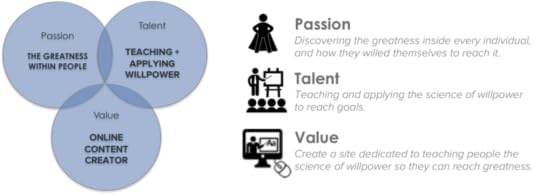
While taking classes, I also began blogging on the science of willpower. My audience, while small, was growing and people were engaging. So I decided my next venture was going to be turning that blog into a business.
I dropped out of my classes, took the money I saved for the PhD, and gave myself 6 months to figure out how to make a living off of Willpowered. That was 19 months ago.
Through that time, I discovered what it truly meant to be passionate.
There were a lot of chances for me to give up, stop trying to make Willpowered work, and move on – like I did with my first startup, and with academia.
But this time I truly loved the work I was doing everyday, and I refused to give up on it without a fight.
I pushed my comfort zone, overcame my weaknesses, and grew as a person with each passing day. So even though even though my bank balance continued to decrease, my happiness in life only increased.
The brutal fact, though, is that happiness doesn't put food on the table.
Even though I was learning and applying new skills to become a better researcher, writer, and entrepreneur – I was not providing enough value to fill that last circle of my hedgehog.
So as of last month, I had to give up working on Willpowered full time… I had to find a way to create more value.

Hedgehog #4
This is wrong...I thought as I read yet another blogger who was passing off his opinion as scientific fact.
Like many others online, this author didn't cite any sources, link to any studies, or have any root in actual science. Worse yet, this person had an online course they were selling and also presented that as science!
I became infuriated.
Here was a person presenting himself as an expert simply because he knew how to market himself online, not because he actually was an expert.
Meanwhile, my heroes of science – who actually are experts – are selling themselves short by confining their ideas to a book, when modern audiences clearly want more content options online.
Then I had to take a hard look in the mirror to realize I was part of the problem.
The reason why thousands of you have supported my work until now is not because I'm the "willpower expert." It's because I work hard to turn scientific research into interesting, relatable, and practical strategies packaged into the content you find valuable.
At that moment, everything clicked. I found my hedgehog.
I discovered the idea that lies perfectly at the intersection of my passion, talent, and value I can bring to society.
I am building a platform that connects content creators who are constantly finding new, innovative ways to package their ideas into valuable online courses, with the actual experts of that content who have no idea these audiences even exist – and just how valuable their expertise truly is.
With the end goal to provide reliable, expert-quality information, presented through innovative, engaging instructors – to give every individual the opportunity to learn, grow, and achieve whatever greatness they seek.


CONCLUSION
Good is the enemy of great. Since I first read those words, I've tried to live them every day of my life.
I've constantly been searching, experimenting, and working toward finding the intersection of my passion, talent, and value–and I believe that now I have found it.
This is just the beginning, obviously, but the combination of my passion, talent, and value is crystal clear.
I cannot believe that I spent the last month sharing an inspiring vision with my heroes. One where their life's work is more valuable than they ever imagined, and where we can ensure that the best ideas, not the loudest voices, are the ones heard by the public.
Now I wake up every day believing that with great scientists and entrepreneurs by my side, together we are going to change the world. All because I didn't settle for "good."
So I wrote this post as a challenge for you to begin searching for your 3 circles.
Whatever your definition of greatness is, if you discover the intersection of your unique passion, talent, and value to society, you will leave this world a better place than you found it.
I look forward to seeing what you accomplish.
Resources to help you find your hedgehog VideoJim Collins on the hedgehog concept
AudioSelf-reflection Questions
At the end of every year, I've asked myself these questions to increase my self-awareness and get closer to my hedgehog. As Jim Collins suggests, I've found it helpful to research myself as if I were an entirely new species to help gain better perspective.
See if these questions help you:
1. What does this species do on a daily basis?
2. What has it accomplished over the last year?
3. What has it accomplished in its lifetime?
4. What does it do differently than any other bug?
5. What can it be better than any other bug in the world at?
6. How is it a useful part of the ecosystem?
7. Why is it here? What is its purpose?
July 18, 2016
[Webinar] 6 Ways to Use Willpower to Beat your Social Nerves, be Likeable, and Improve your Social Skills
If you found this helpful and are looking for more ways to improve your social skills, get your free eBook: 5 Ways to Avoid Awkward Conversations.
This is a webinar by communication coach Katrina Razavi, founder ofCommunicationfornerds.com. Katrina helps people who struggle with social anxiety and social confidence by sharing strategies using change psychology, confidence building, and habit transformation.
July 2, 2016
Create Great Habits Naturally With a "SMaC Formula"
In 1979, Howard Putnam, CEO of Southwest Airlines, faced an extremely difficult decision.
How should he run the company in a newly deregulated market?
As other airlines were scrambling to come up with new business models, Putnam reacted completely differently. He determined that the effects of deregulation, while significant, would not call for a radical change to Southwest’s business model.
So instead of proposing change, Putnam created Southwest’s “recipe” for success based on what made the company successful up to that point.
As with any recipe, he knew it would be important to be specific when talking about ingredients. Directions like “add some sugar” or “bake in the oven until done” are difficult to follow in a recipe. The same holds true when crafting a business model.
Here were the 10 points of his recipe:
Remain a short-haul carrier, under two-hour segments.Utilize the 737 as our primary aircraft for ten to twelve years.Continued high aircraft utilization and quick turns, ten minutes in most cases.The passenger is our #1 product. Do not carry air freight or mail, only small packages which have high profitability and low handling costs.Continued low fares and high frequency of service.Stay out of food services.No interlining ... costs in ticketing, tariffs and computers and our unique airports do not lend themselves to interlining.Retain Texas as our #1 priority and only go interstate if high-density short-haul markets are available to us.Keep the family and people feeling in our service and fun atmosphere aloft. We’re proud of our employees.Keep it simple. Continue cash-register tickets, ten-minute cancellation of reservations at the gate in order to clear standbys, simplified computer system, free drinks in Executive service, free coffee and donuts in the boarding area, no seat selection on board, tape-recorded passenger manifest, bring airplanes and crews home to Dallas each night, only on domicile and maintenance facility.These 10 points are easy to grasp and follow. They are clear and simple. But what is truly amazing about Putnam’s recipe is its consistency over time.
Despite all of the changes that took place during those 25 years…
Southwest still views the passenger as the #1 priority.
They still have stayed out of the food business.
They still have kept the family feeling and fun atmosphere.
And it has helped them still be one of the top airlines in the world.
THE SMAC FORMULAI first learned about Putnam’s 10 points when I read Jim Collins’ book, Great by Choice, in 2012. Collins called these 10 points a “specific methodical and consistent formula” for success (or a “SMaC formula”).
He found that companies that are able to succeed in harsh economic conditions have their own version of a “SMaC formula” that helped keep them achieve stable growth in an unstable world.
This sounded like a great idea for companies…but could it applied to individuals?
At the beginning of 2013, I wanted to find out. So I created my own formula as part of my personal goals…and it completely changed my life.
Almost every success I've had over the last 3 years can be traced back to my SMaC formula which was simply 5 points:
Wake up every weekday at 4 AMPlan my transportation ahead of timeFollow my exercise planLog the food I eatLog the cost of the food I eatThat's it. Simply achieving these 5 points daily led to great habits to reach my goals.
SMaC FORMULA BREAKDOWNHere's what happened when I started implementing these points into my daily life.
Wake up every weekday at 4 AMI wanted to wake up every day 4 AM because I felt like it would create a “platform” for success. It would allow me to get things done early in the morning before the work day even began.
Habits that occurred:
I didn’t stay out late the night before.I turned off all electronics and began reading at 9 PM so I could get enough sleep.I always had time to workout in the morning.I learned how to actually get out of bed when my alarm went off.Planning my transportation ahead of timeLiving in Chicago, there are seemingly infinite number of ways you can go from A to B. By planning ahead, I was able to always prepare for the most efficient and cost-effective transportation ahead of time.
Habits that occurred:
I started preparing everything the night before.I was never late for appointments.I saved money by biking and using public transportation.Follow my exercise planBefore implementing my formula, I found it so easy to justify either not going to the gym, or cutting out early. I knew if I could just follow my exercise plan neither of those would be an option.
Habits that occurred:
I started planning workouts ahead of time.I started tracking my progress and planning to improve.I focused my willpower on pushing through workouts, not coming up with excuses.I allowed myself to feel good about rest days—it was just part of the plan.Log the food I eatI'd read studies that keeping a daily food journal was one of the best ways for people to lose weight. So I knew that by simply keeping track of what I ate, I would start to get control over my diet.
Habits that occurred:
I saw how my diet affected my energy.I saw when I was tempted to snack, so I made sure I had a healthy snack on hand.I was able to switch to the paleo diet and stick to it.Log the cost of foodSince I was already keeping track of the food I was eating, keeping track of the cost of that food was also incredibly beneficial. Paleo diet food can be expensive, so I wanted to see how I could keep my food cost low, while still eating healthy.
Habits that occurred:
I started packing a lunch rather than eating out.I started buying in bulk because I could see the big cost differences.I started creating, and sticking to, a budget for everything other than just food.WHY THE SMAC FORMULA WORKSSo why did this work so well?
Had I set out to create all the habits that eventually sprung up, I would’ve been completely overwhelmed.
There’s no way that within a single year I could have woke up at 4 AM, exercised at least 90 minutes per day, completely overhauled my diet, and stuck to a strict budget.
Yet, I was able to—because those habits weren’t my focus.
My focus was simply on achieving the 5 points in my SMaC formula every single day. The only point that was particularly hard was waking up at 4 AM everyday. The rest I could simply adjust if things got too intense.
Planning my transportation didn’t mean that I had to bike through the snow every day, It just meant that I had to plan ahead.
Following my exercise routine didn’t mean I needed workout 90 minutes every day, it just meant that I needed to follow whatever I planned to do.
Logging my food and the cost of it didn’t mean I needed to follow a strict paleo diet, or follow a strict budget, it just meant that I needed to be aware of what I was eating and how much I was spending on it.
All of these things are completely achievable.
And the habits that came from them just came naturally because they either helped me accomplish these things more effectively, or they just seemed like they were achievable based on my progress.
I’m not saying that this was easy—staying consistent with anything never is—but I can tell you, it was certainly easier to set out to accomplish those 5 things, than to accomplish the habits that surrounded them.
CREATING YOUR SMAC FORMULATo help you create your own SMaC formula, I added my own template below that you can download.
SMaC Formula Template:

Click here to download
It will help you list your unique points, and track whether or not you achieve them.
Simply input:
“Achieved” if you accomplished it.“Failed” if you didn’t.“N/A” if it doesn’t apply (like waking up on the weekends for me).How do you find your points?The points of a great SMaC formula are typically one of three things:
1. They create a platform for other habits to succeed (waking up at 4 AM)
The first characteristic is a great platform for other habits to succeed. My best example of this is waking up at 4 AM because that allowed me time before work to exercise, to read, and to write the early drafts of this blog.
Some other examples of creating a platform would be keeping organized, managing your tasks, etc. any situation in which you can create more time, energy, or focus in your day will act as a platform for other habits to flourish.
2. They increase your self-awareness (logging my food)
The second characteristic is they increase your self-awareness. The more self-aware you are, the better decisions you’ll make naturally. Simply by being aware of the food I ate helped me make better food decisions.
The same can be said for tracking your finances, tracking your time, or track your progress toward your goals. The more information you have on yourself, the better decisions you’ll make.
3. They act as a small win (follow my exercise plan)
Finally, they act as a small win. Do not underestimate the power of a small win. No matter what my exercise plan has been, accomplishing it every single day acts as a huge confidence booster even 3 years later.
Since then, I have added meditation and writing a set number of words per day to my SMaC formula which are also small wins. Anything you can achieve on a daily basis that will increase your confidence and move you closer to your goal will work for your win.
WHAT NOT TO DO WITH YOUR FORMULANow that we have covered the “to-dos” it’s time to cover what “not to-do” which is just as important.
1. Do not overload yourself
The most tempting thing with your formula will be to start off with 10 points on Day 1. Don’t do this. To make sure you get the point I’m going to say it two more times:
Don’t overload yourself.
Don’t overload yourself.
And…one more—don’t overload yourself!
Look at all I was able to accomplish with just 5 points! It’s not necessary—or advisable—to create a formula with a lot of points. The "C" (consistency) in SMaC is by far the most important aspect. Whatever your formula, make sure you can do it consistently.
Today my formula has 8 points. I’ve added meditation, writing 1,000 words/day, and managing all my tasks. And I've been successful with them because I was able to add them organically—after I had created all the habits of the first 5.
Create as few points as possible when you are starting out. The important thing is to be consistent with them, then once you feel like you have a good hold on them, add one more at a time.
2. Do not create “results” points
If you notice, none of my points rely on luck, on others, or even weather. They are all within my control.
I can’t control how many people read an article, but I can control writing a set number words/day.
Results are out of your control. The whole idea behind the SMaC formula is consistency. So focus on process-oriented goals, not results oriented goals.
3. Do not lie to yourself
Despite the extraordinary success I’ve got from my formula, I have not been perfect.
Here is my current record:
Wake up every weekday at 4 AM (95.3%) Planning my transportation ahead of time (99.32%)Follow my exercise plan (91.65%)Log the food I eat (99.5%)Log the food cost (100%)Meditate (91.28%)1,000 words (92.73%)Manage tasks (93.11%)Almost every single time I fail to live up to one of my points I am tempted to mark “Achieved” or “N/A” rather than “Failed.”
But what does that accomplish?
Until today, only one person in the world even knew about my SMaC formula—and he surely doesn’t care what the results are.
Lying to myself degrades the effort I put in on those days where I was exhausted, yet still pushed myself to exercise, to write, or to wake up at 4 AM.
It’s saying that those days are just as important as the day when I skipped my workout and said, “meh, I’ll just mark ‘Achieved’ anyway.”
By being honest with myself, I am able to celebrate the true wins, and learn how to avoid the true losses.
The same will go for you in creating your own formula.
Here it is again in case you want to download:

Click here to download
For the last 3 years, there has been no better single strategy for me than creating my specific, methodical, and consistent success formula—my "SMaC Formula".
It helped me eat healthy, exercise regularly, write a book, build an audience, save money...the list goes on. And I achieved all of these things without even setting out to accomplish them!
To create your own SMaC formula, use the template above and follow the instructions. I hope your results are as good, or even better, than mine!
How to Create a Specific, Methodical, and Consistent Formula for Success
In 1979, Howard Putnam, CEO of Southwest Airlines, faced an extremely difficult decision.
How should he run the company in a newly deregulated market?
As other airlines were scrambling to come up with new business models, Putnam reacted completely differently. He determined that the effects of deregulation, while significant, would not call for a radical change to Southwest’s business model.
So instead of proposing change, Putnam created Southwest’s “recipe” for success based on what made the company successful up to that point.
As with any recipe, he knew it would be important to be specific when talking about ingredients. Directions like “add some sugar” or “bake in the oven until done” are difficult to follow in a recipe. The same holds true when crafting a business model.
Here were the 10 points of his recipe:
Remain a short-haul carrier, under two-hour segments.Utilize the 737 as our primary aircraft for ten to twelve years.Continued high aircraft utilization and quick turns, ten minutes in most cases.The passenger is our #1 product. Do not carry air freight or mail, only small packages which have high profitability and low handling costs.Continued low fares and high frequency of service.Stay out of food services.No interlining ... costs in ticketing, tariffs and computers and our unique airports do not lend themselves to interlining.Retain Texas as our #1 priority and only go interstate if high-density short-haul markets are available to us.Keep the family and people feeling in our service and fun atmosphere aloft. We’re proud of our employees.Keep it simple. Continue cash-register tickets, ten-minute cancellation of reservations at the gate in order to clear standbys, simplified computer system, free drinks in Executive service, free coffee and donuts in the boarding area, no seat selection on board, tape-recorded passenger manifest, bring airplanes and crews home to Dallas each night, only on domicile and maintenance facility.These 10 points are easy to grasp and follow. They are clear and simple. But what is truly amazing about Putnam’s recipe is its consistency over time.
Despite all of the changes that took place during those 25 years…
Southwest still views the passenger as the #1 priority.
They still have stayed out of the food business.
They still have kept the family feeling and fun atmosphere.
And it has helped them still be one of the top airlines in the world.
THE SMAC FORMULAI first learned about Putnam’s 10 points when I read Jim Collins’ book, Great by Choice, in 2012. Collins called these 10 points a “specific methodical and consistent formula” for success (or a “SMaC formula”).
He found that companies that are able to succeed in harsh economic conditions have their own version of a “SMaC formula” that helped keep them achieve stable growth in an unstable world.
This sounded like a great idea for companies…but could it applied to individuals?
At the beginning of 2013, I wanted to find out. So I created my own formula as part of my personal goals…and it completely changed my life.
Almost every success I've had over the last 3 years can be traced back to my SMaC formula which was simply 5 points:
Wake up every weekday at 4 AMPlan my transportation ahead of timeFollow my exercise planLog the food I eatLog the cost of the food I eatThat's it. Simply achieving these 5 points daily led to great habits to reach my goals.
SMaC FORMULA BREAKDOWNHere's what happened when I started implementing these points into my daily life.
Wake up every weekday at 4 AMI wanted to wake up every day 4 AM because I felt like it would create a “platform” for success. It would allow me to get things done early in the morning before the work day even began.
Habits that occurred:
I didn’t stay out late the night before.I turned off all electronics and began reading at 9 PM so I could get enough sleep.I always had time to workout in the morning.I learned how to actually get out of bed when my alarm went off.Planning my transportation ahead of timeLiving in Chicago, there are seemingly infinite number of ways you can go from A to B. By planning ahead, I was able to always prepare for the most efficient and cost-effective transportation ahead of time.
Habits that occurred:
I started preparing everything the night before.I was never late for appointments.I saved money by biking and using public transportation.Follow my exercise planBefore implementing my formula, I found it so easy to justify either not going to the gym, or cutting out early. I knew if I could just follow my exercise plan neither of those would be an option.
Habits that occurred:
I started planning workouts ahead of time.I started tracking my progress and planning to improve.I focused my willpower on pushing through workouts, not coming up with excuses.I allowed myself to feel good about rest days—it was just part of the plan.Log the food I eatI'd read studies that keeping a daily food journal was one of the best ways for people to lose weight. So I knew that by simply keeping track of what I ate, I would start to get control over my diet.
Habits that occurred:
I saw how my diet affected my energy.I saw when I was tempted to snack, so I made sure I had a healthy snack on hand.I was able to switch to the paleo diet and stick to it.Log the cost of foodSince I was already keeping track of the food I was eating, keeping track of the cost of that food was also incredibly beneficial. Paleo diet food can be expensive, so I wanted to see how I could keep my food cost low, while still eating healthy.
Habits that occurred:
I started packing a lunch rather than eating out.I started buying in bulk because I could see the big cost differences.I started creating, and sticking to, a budget for everything other than just food.WHY THE SMAC FORMULA WORKSSo why did this work so well?
Had I set out to create all the habits that eventually sprung up, I would’ve been completely overwhelmed.
There’s no way that within a single year I could have woke up at 4 AM, exercised at least 90 minutes per day, completely overhauled my diet, and stuck to a strict budget.
Yet, I was able to—because those habits weren’t my focus.
My focus was simply on achieving the 5 points in my SMaC formula every single day. The only point that was particularly hard was waking up at 4 AM everyday. The rest I could simply adjust if things got too intense.
Planning my transportation didn’t mean that I had to bike through the snow every day, It just meant that I had to plan ahead.
Following my exercise routine didn’t mean I needed workout 90 minutes every day, it just meant that I needed to follow whatever I planned to do.
Logging my food and the cost of it didn’t mean I needed to follow a strict paleo diet, or follow a strict budget, it just meant that I needed to be aware of what I was eating and how much I was spending on it.
All of these things are completely achievable.
And the habits that came from them just came naturally because they either helped me accomplish these things more effectively, or they just seemed like they were achievable based on my progress.
I’m not saying that this was easy—staying consistent with anything never is—but I can tell you, it was certainly easier to set out to accomplish those 5 things, than to accomplish the habits that surrounded them.
CREATING YOUR SMAC FORMULATo help you create your own SMaC formula, I added my own template below that you can download.
SMaC Formula Template:

Click here to download
It will help you list your unique points, and track whether or not you achieve them.
Simply input:
“Achieved” if you accomplished it.“Failed” if you didn’t.“N/A” if it doesn’t apply (like waking up on the weekends for me).How do you find your points?The points of a great SMaC formula are typically one of three things:
1. They create a platform for other habits to succeed (waking up at 4 AM)
The first characteristic is a great platform for other habits to succeed. My best example of this is waking up at 4 AM because that allowed me time before work to exercise, to read, and to write the early drafts of this blog.
Some other examples of creating a platform would be keeping organized, managing your tasks, etc. any situation in which you can create more time, energy, or focus in your day will act as a platform for other habits to flourish.
2. They increase your self-awareness (logging my food)
The second characteristic is they increase your self-awareness. The more self-aware you are, the better decisions you’ll make naturally. Simply by being aware of the food I ate helped me make better food decisions.
The same can be said for tracking your finances, tracking your time, or track your progress toward your goals. The more information you have on yourself, the better decisions you’ll make.
3. They act as a small win (follow my exercise plan)
Finally, they act as a small win. Do not underestimate the power of a small win. No matter what my exercise plan has been, accomplishing it every single day acts as a huge confidence booster even 3 years later.
Since then, I have added meditation and writing a set number of words per day to my SMaC formula which are also small wins. Anything you can achieve on a daily basis that will increase your confidence and move you closer to your goal will work for your win.
WHAT NOT TO DO WITH YOUR FORMULANow that we have covered the “to-dos” it’s time to cover what “not to-do” which is just as important.
1. Do not overload yourself
The most tempting thing with your formula will be to start off with 10 points on Day 1. Don’t do this. To make sure you get the point I’m going to say it two more times:
Don’t overload yourself.
Don’t overload yourself.
And…one more—don’t overload yourself!
Look at all I was able to accomplish with just 5 points! It’s not necessary—or advisable—to create a formula with a lot of points. The "C" (consistency) in SMaC is by far the most important aspect. Whatever your formula, make sure you can do it consistently.
Today my formula has 8 points. I’ve added meditation, writing 1,000 words/day, and manage all my tasks. And I've been successful with them because I was able to add them organically—after I had created all the habits of the first 5.
Create as few points as possible when you are starting out. The important thing is to be consistent with them, then once you feel like you have a good hold on them, add one more at a time.
2. Do not create “results” points
If you notice, none of my points rely on luck, on others, or even weather. They are all within my control.
I can’t control how many people read an article, but I can control writing a set number words/day.
Results are out of your control. The whole idea behind the SMaC formula is consistency. So focus on process-oriented goals, not results oriented goals.
3. Do not lie to yourself
Despite the extraordinary success I’ve got from my formula, I have not been perfect.
Here is my current record:
Wake up every weekday at 4 AM (95.3%) Planning my transportation ahead of time (99.32%)Follow my exercise plan (91.65%)Log the food I eat (99.5%)Log the food cost (100%)Meditate (91.28%)1,000 words (92.73%)Manage tasks (93.11%)Almost every single time I fail to live up to one of my points I am tempted to mark “Achieved” or “N/A” rather than “Failed.”
But what does that accomplish?
Until today, only one person in the world even knew about my SMaC formula—and he surely doesn’t care what the results are.
Lying to myself degrades the effort I put in on those days where I was exhausted, yet still pushed myself to exercise, to write, or to wake up at 4 AM.
It’s saying that those days are just as important as the day when I skipped my workout and said, “meh, I’ll just mark ‘Achieved’ anyway.”
By being honest with myself, I am able to celebrate the true wins, and learn how to avoid the true losses.
The same will go for you in creating your own formula.
Here it is again in case you want to download:

Click here to download
For the last 3 years, there has been no better single strategy for me than creating my specific, methodical, and consistent success formula—my "SMaC Formula".
It helped me eat healthy, exercise regularly, write a book, build an audience, save money...the list goes on. And I achieved all of these things without even setting out to accomplish them!
To create your own SMaC formula, use the template above and follow the instructions. I hope your results are as good, or even better, than mine!
June 29, 2016
8 Movies That Will Give You a Rush of Willpower
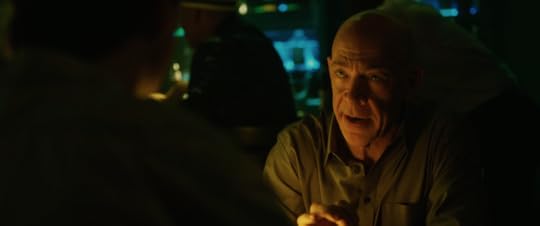
"Have I told you that story about how Charlie Parker became Charlie Parker? Parker's a young kid, pretty good on the sax. Gets up to play at a cutting session… and he (screws) it up...and he's laughed off-stage. Cries himself to sleep that night.
But the next morning, what does he do? He practices. And he practices and he practices with one goal in mind: Never to be laughed at again.
And a year later, he goes back to the Reno... And he steps up on that stage and he plays the best solo the world has ever heard.
So imagine if Jones had just said: 'Well, that's okay Charlie. Eh... that was alright. Good job.' Then Charlie thinks to himself, 'Well, I did do a pretty good job.' End of story, no 'Bird.' That, to me, is... an absolute tragedy.
There are no two words in the English language more harmful... Than 'good job.'"
I was floored when I heard JK Simmons say those words in his Oscar-winning performance in the 2014 movie, Whiplash.
That speech completely changed my perspective on how to become truly great in my field. I think about it probably once per week, and whenever I do it gives me a rush of willpower to keep pushing and never settle for "good enough."
That is the power of inspiration you can get from a movie.
INSPIRATION FROM MOVIESI've been writing a lot recently about the power of stories. And another place you can look for that inspirational power is from movies.
Whiplash is my personal favorite because it shows the grittier side to the pursuit of excellence. Rather than show the "ra ra" speeches, it shows the sacrifices. However, like any piece of art, you may see it completely differently.
So I wanted to see which movies others use as their source of inspiration. To do this, I reached out to fellow writers from around the world to see which movies inspire them and why.
Here are their favorites. I hope they fuel your willpower as well!

Sam Thomas Davies
Writer and Researcher at SamuelThomasDavies.com (Sweden)
Movie: Rush
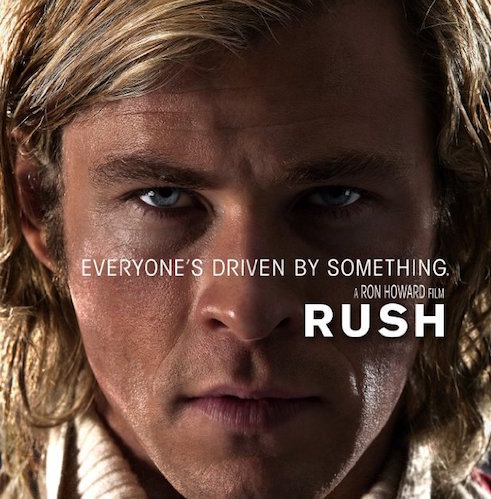
Summary: Centered on the rivalry between Formula 1 drivers James Hunt and Niki Lauda during the 1976 Formula One motor-racing season, Rush is a pedal-to-the-metal blockbuster that will leave you on the edge of your seat from start to finish. The rise and fall (and rise) of Niki Lauda is what inspires me most. I won't spoil it, but his comeback is one that reminds us that we already have everything we need to be anything we want.
Favorite quote: " A wise man can learn more from his enemies than a fool from his friends." - Niki Lauda
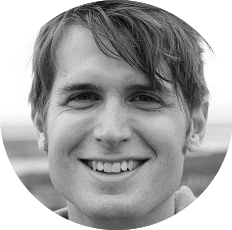
Patrik Edblad
Writer, mental trainer & personal coach at Selfication.com (Sweden)
Movie: Remember the Titans
Summary: The true story of how African American coach Herman Boone controversially is made head coach over the highly successful white coach Bill Yoast at T.C. Williams High School, Virginia. This movie always gives me a rush of inspiration because of all its amazing scenes where the young black and white players learn how to look past their differences and work together as a team. If you're looking for a touching movie with plenty of inspirational moments and have somehow missed Remember the Titans, now is the time to go see it!
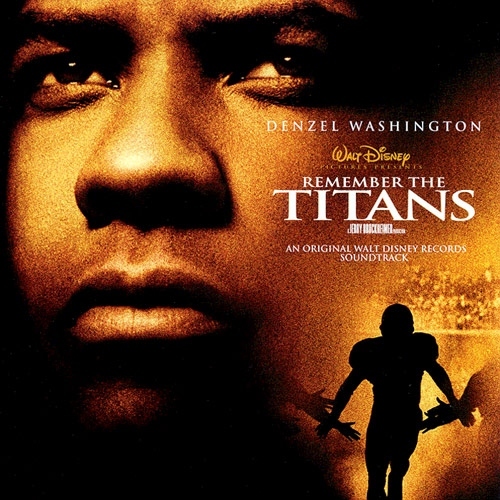
Favorite quote: "This is where they fought the battle of Gettysburg. Fifty thousand men died right here on this field, fighting the same fight that we are still fighting among ourselves today. This green field right here, painted red, bubblin' with the blood of young boys. Smoke and hot lead pouring right through their bodies. Listen to their souls, men. I killed my brother with malice in my heart. Hatred destroyed my family. You listen, and you take a lesson from the dead. If we don't come together right now on this hallowed ground, we too will be destroyed, just like they were. I don't care if you like each other of not, but you will respect each other. And maybe... I don't know, maybe we'll learn to play this game like men." - Coach Boone

Niklas Goeke
Chief Book Nerd at Four Minute Books (Germany)
Movie: Unbroken
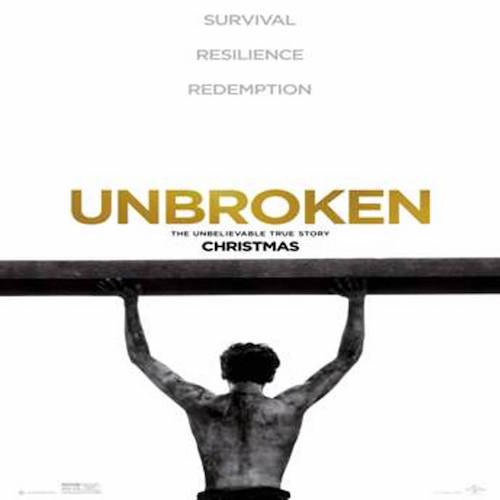
Summary: Watching Louis Zamperini survive plane crashes, shark attacks, starvation, torture and the most inhuman conditions thanks to his prepared body and unbreakable spirit leaves me empowered every time. Based on true events, you can't help but think: "If a normal guy like Louis can do this, I sure can solve my problem." If you ever need the willpower to make it through a stretch of discipline and hard work, this movie will give you the boost you need.
Quote: If you can take it, you can make it. - Louis Zamperini
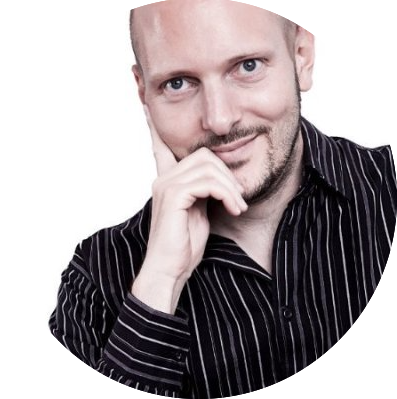
Miguel Guzman Miranda
Personal development coach & writer at Exito-personal.com (Spain)
Movie: The 13th Warrior
Summary: Vikings tales evoke strength, honor and willpower. In this adventure each of the warriors stands for one of the qualities that comprise the will of heroes.

Edgtho artfully applies his smarts and cunning; Herger takes all challenges always with joy, an uplifting smile and a playful joke; Helfdane stands proud even in the face of death; Ahmed intelligently adapts to survive and thrive; and most of them all Buliwyf (Beowulf) who fights against all odds until the very end.
Will you join the warriors?
Quote:
Ahmed Ibn Fahdian: (Given a Viking sword) "I cannot lift this."
Herger the Joyous: "Grow stronger."

Katrina Razavi
Entrepreneurship & Marketing, Founder of CommunicationforNerds.com (USA)
Movie: Erin Brokovich

Summary: Underdogs can win- Erin didn’t have much going for her other than her strong willpower and determination. She didn’t have a law degree, she wasn’t an investigator and she didn’t “look the part." But she didn’t care what others thought and in the end, she proved them all wrong.
Quote: “If you follow your heart, if you listen to your gut, and if you extend your hand to help another, not for any agenda, but for the sake of humanity, you are going to find the truth.” - Erin Brockovich

Benjamin Austin
Writer, Founder of StopStartDo.com (USA)
Movie: Fight Club
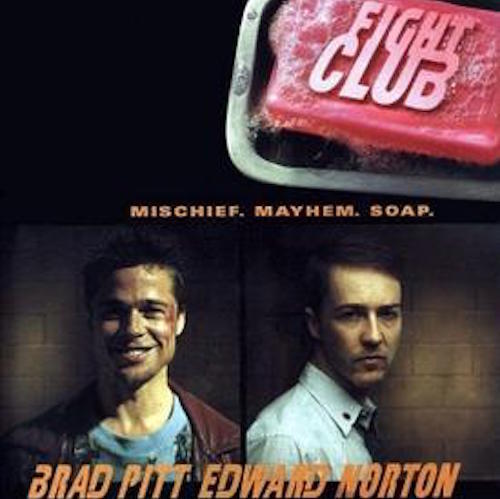
Summary: Fight Club is a reminder that at any time you can choose to change your life. In an instant you can decide and do the thing you always wanted. You can be the person you always wanted to be. You don't need permission.
Quote: "This is your life and it's ending one minute at a time" - The Narrator

Greg Johnston
Products, Marketing + Social Media Guy, Mentor+ (Canada)
Movie: The Pursuit of Happyness
Summary: Life is a struggle for single father Chris Gardner. Evicted from their apartment, he and his young son find themselves alone with no place to go. Even though Chris eventually lands a job as an intern at a prestigious brokerage firm, the position pays no money. The pair must live in shelters and endure many hardships, but Chris refuses to give in to despair as he struggles to create a better life for himself and his son.
His talents and skills, along with his willpower and honest personality, earned the trust of several people who signed contracts with the brokerage firm. In the end, he goes on to get a paid position and his life changed dramatically from that moment.
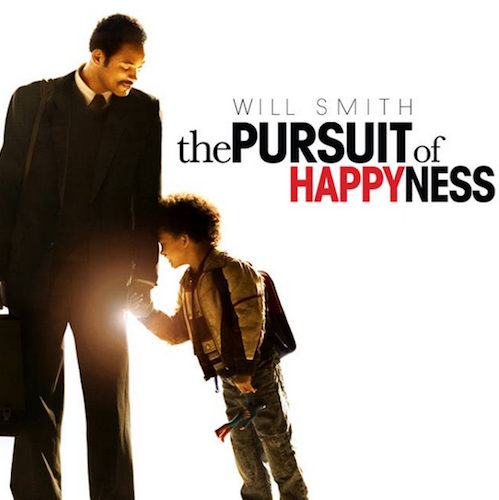
Quote:
Christopher Gardner: "Hey. Don't ever let somebody tell you... You can't do something. Not even me. All right?"
Christopher Jr: "All right."
Christopher Gardner: “You got a dream... You gotta protect it. People can't do somethin' themselves, they wanna tell you-you can't do it. If you want somethin', go get it. Period.”
Do not underestimate the power of a movie to inspire you to take action. These are some of the best picks from my fellow writers around the globe, and I hope they help you when you need a boost.
But, I would love to know, what movies have we missed? What movie inspires you?
Comment below and let us know!
June 16, 2016
How to Maximize Your Willpower as an Introvert or Extrovert
The notecards in my hands were shaking as I rehearsed the speech in my head...
I was about to do my first pitch to a room of investors in my entrepreneurial career. As the clock ticked down to my turn to speak, I no longer feared being on stage…I feared having a panic attack before I got there.
As I tried calming myself down and rehearsing my presentation points, I saw presenters before me that made it look so easy.
They were confident, charismatic, and effective.
Why couldn’t I have that same confidence? I actually have a product and customers...some of these guys have barely more than an idea!
You can do this. I thought. If you want to succeed as an entrepreneur, THIS is what you have to do.
I wasn't a disaster. I was just stiff, robobotic, and completely drained by the experience.
I didn’t stay for the networking I knew would be incredibly valuable,,,I needed some time alone to recharge.
Several of the companies that pitched that day set up further meetings with investors…mine wasn’t one of them.
Such is the life of the introverted entrepreneur.
THE EXTROVERT ADVANTAGE
It’s no secret that extroverts have a big advantage in the marketplace.
The investors that day believed a better indicator of company success was how well the founder performed in those 10 minutes on stage—rather than the 40+ hours/week they spent in the office (although, to be fair, none of us ended up being a good investment).
This same advantage occurs in almost every area of life:
- It’s the charismatic speaker who usually win the election.
- It’s the "people person" who is usually given the promotion.
- And it is the best interviewer that usually gets the job.
This is not meant to be an attack on extroverts–or to say that some of these advantages aren’t justified–but these facts have led many introverts like me to believe our introverted nature is a disadvantage.
I was so ashamed of it that I even lied on my Myers Brigs personality test so I would be classified as an extrovert!
After that speech, I decided to finally overcome my introversion. And, like all my other challenges, I turned to science for the answer.
What I learned change the course of my life.
Not because I overcame my introversion, but because I learned how to embrace it. I learned how both introverts and extroverts can use their natural strengths to achieve more in work and life. [1]
So whether you're introverted or extrroverted, this article will help you use your strength more effectively–and hopefully help you understand your opposite a little bit better.
THE SPECTRUM
The first thing to understand is that classification as an introver or extrovert is not a simple "A or B" choice. It’s a spectrum.
To illustrate the different points along this spectrum, I’m going to use an example of myself, and the co-founders that soon joined me on the startup I was pitching that day: Jeff and Maggie.
If this spectrum was between 1 and 10, I would lie at about a 3, Jeff about be about a 5, and Maggie would be about a 9.
To see where you lie on the spectrum, you can take this quick quiz.
Here are 4 key situations in which we differed along the spectrum. It will explain our nature, how that impacted our teamwork, and strategies that will help you use your strengths to maximize your willpower.
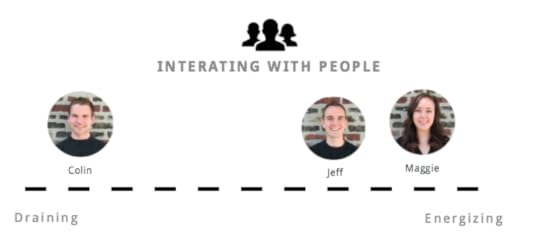
Nature
Interating with people is probably the biggest difference between introverts and extroverts—and it's the one most visible in society.
To introverts like me, spending time with large groups of people—especially strangers—completely drains our willpower. I personally need to spend time before and after large group gatherings by myself to recharge my batteries.
Extroverts like Maggie, on the other hand, actually increase their willpower by spending time interacting with others at networking events. It's her chance to be her best self and embrace her natural charm and charisma.
Ambiverts like Jeff can go either way. He is on the extroverted side of this equation, as he likes interacting with people, but can easily spend time alone at home as well. He doesn't need to recharge with either, and can find both stimulating.
Contrary to what many believe, this is not because introverts don't like people and extroverts do, it's because of our sensitivity to stimulation.
Researches have found that introvert babies will start to cry in situations where there are too many people in the room. While extrovert babies will laugh. [2]
Impact on Work
To maximize our strengths, despite the fact that I was technically the "CEO", Maggie was the one doing all the fundraising/networking for our company, and Jeff did the presentations to any investors.
This played well for our strengths, but almost nobody outside our company even knew what my role was.
With Maggie owning every room she entered, Jeff taking the stage at presentations, and my impact taking place behind the scenes, few people knew who the quiet guy in the back was–which was fine with me.
Any gains from clarity to the outside world were not nearly as big as the value that we got from embracing our natural gifts, maximizing our willpower, and putting the best work out there.
To Maximize Willpower
Introverts:
Let go of the feeling that you need to be charismatic and outgoing. Embrace the benefits you get from drawing energy from yourself instead of others.
However, you must identify those situations where you must be more extroverted to reach your purpose. Push yourself enough to be competent, but don't feel like you need to become Tony Robbins.
Extroverts:
Plan to involve friends and coworkers in your goals more often. Embrace your ability to boost your willpower from them.
But similarly, identify those moments when you're going to have to spend time in quiet focus on a project alone. Learn how to adapt to those situations, but don't be yourself up if you feel cooped up after a while.
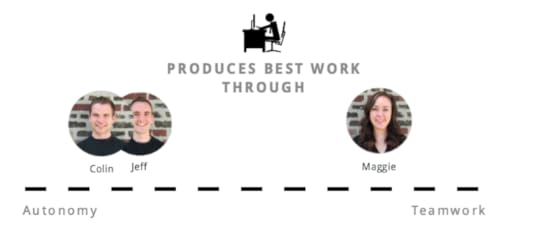
Nature
Work environment is one of the most important factors for maximizing willpower because it varies so significantly between introverts and extroverts. And companies usually get this dynamic wrong...
Jeff and I are both introverts in our work. We love isolation, focus, and quiet. We like to identify the goal, work by ourselves on completing it, then get feedback afterward.
Maggie, on the other hand, likes a collaborative environment. Extroverts like her want to bounce ideas off of you and work together on a project, rather than waiting to get feedback after it's complete. [3]
Impact on Work
This was the hardest issue for us to deal with.
With Jeff and I focusing on our work, Maggie didn't have anyone to bounce ideas off of. She's used to getting consistent feedback as she works, so she would ask us questions to make sure she was on the right path.
This meant interrupting the focus of me or Jeff who didn't like losing our focus. This left all of us feeling frustrated as we just couldn't find the right work environement where everyone was happy.
Unfortunately, we were never able to find the right dynamic. But we did take what we learned with us.
To Maximize Willpower
Introverts:
Try to work on your own in a quiet, focused environment. There is a bias for teamwork in many companies, but it isn't best for everyone.
Today, Jeff isn't able to do his best work when he's put on projects with creative collaboration.
I'm an extreme example, but when I moved to an entirely new city by myself to finish The Will of Heroes, I was instantly in productivity heaven.
Extroverts:
Try to engage in work that allows you to be collaborative and work with others.
Today, Maggie leads a team of sales people, gives talks all around the country, and gets to use her willpower infinitely more effectively by embracing her natural strengths.

Nature
We usually equate leadership with charisma and motivation–which extroverts are extremely good at delivering. They have both the abitily draw energy from the charisma of others, and also instil that charisma into the team around them.
But many introverts don't need–or even want–charismatic leadership to motivate them. [4]
Introverts like Jeff and I draw motivation from within. We like to work on our own to figure things out. So we respond the best to leadership that trusts us to know what we're doing, then provides feedback on the end result.
This is how I wanted to lead the team as well.
Impact on Work
This was another area of struggle for us. As the leader, I wanted to bring the best out of Maggie and Jeff. But to me, that meant setting an example, granting autonomy, and providing insightful feedback.
Jeff was more than happy with this, but it was at odds with Maggie's nature.
On her end, she expected me to work with her, motivate her, and provide that source of energy that she and other extroverts draw from. Meanwhile, I expected her to get that energy from within.
Once again, leaving us both frustrated as we had differing expectations for each other. 4
To Maximize WillpowerIntroverts:
- If you're an introvert, studies show you'll be a better leader of other introverts, and more highly-skilled employees.
- Jeff is a great example of this as he is now leading a team of software developers.
Extroverts:
- If you're an extrovert you'll be better at leading other extroverts, and also lower skilled employees.
- Maggie, as I previously mentioned, has also embraced this by leading a team of salesmen.
Be self-aware if you are leading or are led by someone that is opposite from you. Neither of these styles is right or wrong. But they can become frustrating or, even counter-productive, without proper communication.
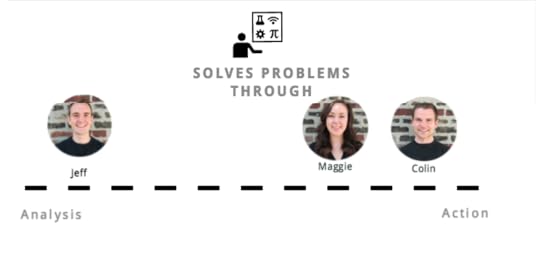
Nature
At this point, some of you may be wondering, "Colin, if you're a lousy speaker, not a motivational leader, and just want to work by yourself, why are you evenan entrepreneur?" This point on the spectrum has the answer.
Typically, introverts favor analysis over action. Because they rely on themselves for the answers, like to look at the problem from every angle before taking action. As you can see, Jeff is a perfect example of this, but I am now.
On this point, Maggie and I are on the extroverted side. Extroverts or much less risk-averse. They like to take action, see what happens, and adjust based on the feedback. Rather than plan the perfect strategy.
I'll fully admit, this has got me into hot water from time to time. But I certainly wouldn't be writing to you today if I didn't have this extroverted side of myself.
Impact on Work
Typically in the business world, the path success is fairly clear. You have your working business model, systems, and brand recognition with a customer.
In the startup game, however, everything is unknown. You're usually targeting a whole new market, with a whole new product, and hoping your predictions are correct. But they never are–there are simply too many unknowns!
So my first inclination was to say that plans are useless. Jeff was there to remind us that plans may be useless but planning is priceless. And Maggie provided a good middle ground.
To Maximize WillpowerIntroverts:
If you're an introvert, ensure that you're not over analyzing things. There is no perfect solution, and eventually you need to take action.
And be sure to speak up if you see extroverts taking too much risky action. Much of the 2008 financial crisis was due to over ambitious action that wasn't calmed down by those who thought twice.
Extroverts:
If you're an extrovert, use your propensity for action to learn from experience faster than introverts can. It's a huge advantage.
But make sure you're not downplaying risk too much. If you take a risk and fail, learn from the experience. Too often extroverts double-down after a loss and lose control. [5]
Conclusion
When I started my entrepreneurial career, I was ashamed of my introverted nature. I believed I would never be successful without becoming as charismatic and outgoing as someone like Maggie.
But by learning the science behind my introversion, I came to the understanding that it's a detrement to myself and society to go against my nature. Just it would be for Maggie to spend her days cooped up in an office.
Going against your natural strength is like a 7'2 trying to play soccer. Sure, he technically can do it, but it will require a lot more willpower to ignore his gift of heigh, than to embrace it by playing basketball.
There are moments, however, where both introverts and extroverts need to stretch our comfor zone. Introverts will waste countless hours of work by not presenting it properly. And extroverts will struggle to reach goals if they don't learn how to reach them alone.
Prepare for those moments, and summon the willpower to stretch yourself toward the middle of the spectrum. You don't need to be perfect, you just need to be good enough to let your true talents shine.
June 9, 2016
How to Use Stories to Inspire Action...When All You Want to Do Is Procrastinate
January 7th, 2016
Another morning…another day where I am just staring blankly at the computer screen.
I need to continue working on the manuscript that I started years ago, that I raised over $13,000 to publish with professional quality, and that I need to edit.
But the bills keep piling up, and this process is longer and more expensive than I expected.
To finish the book, I moved to a new city all by myself. This way I would have more time, more focus, and fewer distractions to help me complete it with excellence.
But even through I’m looking at the manuscript, without any distractions in my environment, I feel like I just can’t handle the work I have to do today.
I don’t want to face how big the project is.
I don’t want to face the fact that whatever I put out there will be harshly criticized.
I don’t want to face the possibility that the people who believed in me and backed the project on Kickstarter may be disappointed—and feel like their support of my work wasn’t worth it.
This is all too much to handle for me right now…Maybe I need to take a break from this project for the day. I’ll probably feel better tomorrow anyway…
Finding INSPIRATION When I Needed it mostWait, what am I saying?
Think about when J.K. Rowling was writing her first Harry Potter book.
Her bills were piling up much worse than mine.
She had to worry about taking care of her infant daughter...I only need to worry about myself.
She had to face cold rainy winters in Edinburgh...meanwhile it’s January and I’m in Florida with weather nice enough to go to beach.
She was in a constant battle with depression...and I'm only battling with procrastination.
And she had no guarantee that anyone would even read her book, let alone get over $13,000 in pre-orders for it.
Yet, despite all of this, somehow she managed to spend 5 years writing with extraordinary consistency.
She created an amazing new world of magic that would open up our imaginations. And she obsessed over every detail—even writing the name, house, and magic abilities of every student at Hogwarts!
Then, she reaped the benefits of not giving up, and persevering through every obstacle she face,d by producing the first book in the most successful book series of all time.
If she could do all of that, I can spend a mere 4 hours working on my manuscript like I planned.
The Power of Stories to Inspire ActionThis is a passage taken from my daily journal in January of this year (roughly 2 months before the release of The Will of Heroes). But it could have been taken from any of the many days where I was feeling tired, stressed, and demotivated over the last 5 years.
We all have these days. It doesn’t matter if your goal is writing, selling, or making it to the gym, you have had (and will continue to have) days like this from time to time. And on these days, there's nothing we want more than to put our work off until tomorrow.
To procrastinate is human. A whopping 95% of people admit to procrastinating at least some of the time—and the other 5% are lying. But just because it is natural, doesn't mean it isn't dangerous.
In fact, procrastination is the key reason why roughly 9 out of 10 people will never reach their long-term goals. 9 out of 10!
I don’t know how many days exactly I’ve woken up, stared blankly at the computer screen, and felt the overwhelming urge to procrastinate. But I do know that every day I felt that way, I thought about the story of J.K. Rowling.
I thought about the hardships she faced...
The obstacles she overcame...
And the greatness she proved was possible.
Her story has always been enough to inspire me to ignore procrastination, and take action.
HOW to USE STORIES to INSPIRe ActionIf you’ve been following my work for a while, you know that I love to tell stories about how people used their willpower to achieve greatness (you may even be sick of hearing about J.K. Rowling at this point...)
However, I’ve never explained how to actually apply stories to your daily challenges. Nor have I explained the science behind why they can be powerful motivators when you face those inevitable demotivated days on the journey to your goals.
So let's break down the proven reasons why J.K. Rowling's story can inspire me to take action, when all I want to do is procrastinate—and how you can find that same drive for action through your own inspirational stories.
1. SHIFTING YOUR PERSPECTIVEAs I mentioned in my journal entry, my situation in January wasn’t nearly as hard as J.K. Rowling’s when she was also writing her first book.
I’m not saying that my situation was better, necessarily. Some of you might find my lifestyle lonely and boring, and would prefer her life as a parent. But, if nothing else, my situation was certainly easier to handle.
Despite this, my initial thoughts were solely focused on feeling sorry for myself.
I’m broke…
I’m exhausted…
I’m overwhelmed…
I don’t know if I can take it…
But when I mentally rehearsed the situation that Rowling was in at my age, I shifted my perspective (also referred to as frame of reference). Then I clearly saw that my daily struggle wasn’t nearly as hard as what she was going through.
And if she could find the time to write in addition to being a single mother, then I knew I could find the time to write in an environment that I had intentionally set up to be free of distractions.
After shifting my perspective in this way, the challenge didn’t seem so overwhelming, and my writing goal seemed that much more achievable.
This simple shift gave me just enough willpower to get started writing. Then I became immersed in the task, achieved small wins, and hit my daily goal.
Your perspective on your situation, your work, or yourself, can have a big impact on your willpower.
If you see your situation as something you can't control, you will drain your willpower to improve it. You will start feeling sorry for yourself. You will be tempted to come up with all of the reasons you shouldn't have to work toward your goal today, and that you deserve to take a break.
If you see your situation through the eyes of someone who inspires you, even if that is simply the person you're working to become, you will get a boost of willpower to improve your situation. And a story is one of the best ways to shift how you view these things.
There’s a reason why religious books are told in stories. Reading about the generosity and kindness of a spiritual leader will shift your perspective to see the bigger picture and give you more willpower to be selfless as well.
This same principle can be applied to a story about someone in your life that you admire, reading a rags-to-riches story, or even watching an inspirational movie. As the story plays out, your brain will visualize yourself in their shoes and shift your perspective.
2. BECOMING GRATEFULAnother benefit to thinking about J.K. Rowling’s story, is that it also helped me become grateful for all the good things in my life.
I have proven interest in my book!
I have an amazing audience that supports me!
I can even play beach volleyball in January!
These are all things I knew intellectually, but it wasn’t until I thought of Rowling’s story that I truly appreciated them. And that gratitude also increased my willpower.
As my friend Ben Austin wrote about in this guest post, simply being grateful benefits your willpower in big ways.
BENEFIT 1: GRATITUDE FOCUSES YOUR RASThe RAS (reticular activating system) is a bundle of nerves that is attached to your brainstem and acts as a filter for everything going in and out of your brain.
When you focus your attention on the good things in your life, your brain will filter out the bad and prevent your subconscious from overreacting to harmless “threats”. This allows you to create more willpower, retain your existing willpower stores, and focus on the tasks that matter. [3]
BENEFIT 2: PREFRONTAL CORTEX ACTIVITY INCREASESThe Prefrontal Cortex (PFC) is the part of your brain associated with willpower and problem solving. In other words, gratitude makes you tougher and more resilient.
Resilient people activate their PFC and dominate. Resistant people activate their fight-or-flight nervous system and get pushed around by life. [1]
BENEFIT 3: EXPAND YOUR SELF CONCEPTAccording to psychologist Carl Rogers, gratitude expands your Self-Concept, which consists of 3 things:
1. Self-image, or how you see yourself.
2. Self-esteem, or how much you value yourself.
3. Ideal self, or how you wish you could be.
When your self-concept expands, all areas of your life benefit. A gratitude practice allows you to have more confidence, value your achievements, and work towards your goals. [7]
Expanding your self-concept allows you to see the true value you bring in this world. It’s a powerful feeling and allows you to increase your impact and do the work that actually matters.
If you read an inspiring story about someone with fewer resources than you, yet was still able to achieve and admirable goal, it will make you grateful for the resources you have. And it will give you more confidence that you can reach your goals too.
3. PROVING WHAT IS POSSIBLEThis is the part of J.K. Rowling's story that truly inspires me.
Not only did she face a daily struggle to write Harry Potter, but she endured that struggle for roughly 1,825 days! From the initial idea of a boy going to a school for Witchcraft and Wizardry, to the ultimate publication–she wrote, she created, she edited, and she never gave up.
Think about how many days she must have woken up with the same feelings of exhaustion and demotivation that I wrote about–and she had the additional responsibility of being a single mother!
Without any promises of publication, without any outside validation that the book would be a success, and with the huge responsibility to provide a good life for her daughter, Rowling must have thought about giving up hundreds of times.
And imagine if she did?
Not only did her books bring happiness and imagination to people all over the world, but they also got children like me to learn the wonder that could be found in books, at a time when many kids were shifting to video games.
I cannot image what the world would look like today if she made the rational, reasonable decision to quit. If that happened, I doubt I would be writing these or any words to you right now.
But the truly profound question is...
How many others have faced similar struggles to Rowling, but actually did quit before they created the great work they were truly capable of?
We will never know for sure, but the number must be far more than those who never gave up.
In my own journey, sharing the science of willpower with the world has not been easy. It's been a bumpy road, but I am making progress every day. And Rowling’s story has given me endless inspiration to make sure of that.
I doubt you or I will ever captivate the world like she did. But her story proves that if we can avoid procrastination, avoid the temptation to quit, and persevere through our own struggles along the path, it will be worth the effort.
CONCLUSIONGreatness doesn’t come from innate gifts, a brilliant idea, or even from a story by itself. It comes from choosing to embark on the journey and making progress every single day until you reach the destination.
Unfortunately, our nature is to ignore this truth and procrastinate when we hit the inevitable days of exhaustion and demotivation along the way. Taken alone, it won't do much harm, but procrastinating one day sets the precedent to procrastinate again...then again.
When I face these challenges in my work, I turn to the story of J.K. Rowling. Thinking about her 5 years of struggle, and her will to persevere through them, shifts my perspective to see my work as achievable. It helps me become grateful for what I have, and it reminds me to never give up.
The world is a better place because J.K. Rowling believed Harry Potter’s story was too important to give up on. And it will be a better place if you find something to work on that is just as important to you—as long as you have the will to never give up on it.
June 2, 2016
How Can You Amplify Willpower? My Interview on Unleash Your Inner Genius
Last week, I sat down with Ben Austin, the founder of Stop Start Do and the host of the Unleash Your Inner Genius Podcast!
We talk about the keys to mastering willpower, the best habits, and more!
In our interview WE cover topics like:Q: What are the most common reasons someone would want to understand willpower and how to improve it? What has improving your willpower allowed you to do in your career?Q: What caused you to be so interested in the science of willpower? And what's the story behind willpowered.co?Q: What are some of the most common misconceptions about willpower?Q: Most people dream about achieving their goals in business, health, love or happiness and yet so many of us fail to follow though. It's March as of this recording and most people have fallen off their new year's resolutions. How do we use the science of willpower to stick with and achieve our goals?Q: Let's talk about your recently released book the Will of Heroes. What's it about and how can someone benefit from reading your book?Q: Most people including myself have dreamed about writing a book and few of us actually do it. What skills, habits and routines did you need to develop in to write the Will of Heroes?Q: What did you learn about yourself going through the process of writing the book?Q: Let's talk about your habits and personal productivity. What are the productivity habits you personally swear by?Q: What does your daily routine look like?Q: Who were your mentors (either in person or virtual) and how did they help you streamline your growth as an entrepreneur and writer?Q: What are you most excited about right now?RAPID FIRE QUESTIONS:What is the #1 habit you contribute most to your success? Typing 1,000 words per dayWhat is the #1 book you’ve recommended to others and why? Mastery , Willpower Instinct and the Will of Heroes.What is your favorite online tool or app? SumoMeWhat podcasts do you tune into regularly? Audible and Joe RoganBefore you take off, can you let us know where the best place is to connect with you? www.Willpowered.CoMay 26, 2016
The Best Method for Finding Your Path to Success (That Most People Get REALLY Wrong)
Are you a good problem solver?
If so, think about a problem that is currently stressing you out.
It could be in your work, your relationships, anything. However, it must be realistically solvable (ending world hunger will have to wait for another time).
Got your problem?
Okay, now think about which of these methods will be most effective in coming up with a solution:
1. Create a planSpend the next week researching, brainstorming, and coming up with a plan:
Learn more about your problem.Think about what you can do to solve it.Write down your next steps.2. Event-simulationSpend 5 minutes/day for the next week mentally rehearsing how this problem arose:
Visualize the beginning of the problem: go over every detail that lead to the first incident.Visualize each step since: what happened to make things better or worse since then?Visualize the actions you took: remember what you said and did at each step. Visualize the environment you were in: where were you, who was around you, and what did they say?3. Outcome-simulationSpend 5 minutes/day for the next week visualizing the problem being resolved and being free of the stressful situation:
Picture the relief you feel.Visualize your satisfaction having dealt with the problem.Picture the confidence you will feel in yourself knowing that you have successfully dealt with the problem.Which of these methods do you believe will help you solve your problem most effectively?
Review them again.
....
Have your prediction?
When researchers put 3 groups of participants through this actual practice, the event-simulation group greatly out-performed the other two on almost every measure. [1]
Before the week was even over, the event-simulation group started taking action towards solving their problem—and many actually did!
They were also more likely to:
Seek out advice from others.Feel positive about themselves and their situation.Report that they learned and grew from the experience.These results seem to make no sense. When you think about it, they were visualizing failure, yet somehow they felt even more positive about themselves than those who visualized success!
So why did the event-simulation work so much more effectively?
OUTCOME-VISUALIZATIONWhat you may think:
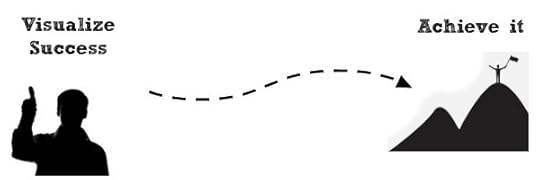
Visualization is powerful. So powerful, in fact, that your brain will actually treat visualizations the same way it treats real events.
When I first started as an entrepreneur, I tried to harness this power through the “law of attraction.” According to this law, if I visualized people investing in me, co-founders partnering with me, and customers loving my products, then I would believe these have all actually happened. [2]
Ideally, this would give me the confidence and willpower to make my visualization a reality.
So I visualized success every day...but it wasn't my confidence that increased, it was my frustration.
I didn't realize it at the time, but I was getting frustrated by the fact that there was such a wide gap between my daily struggle and what my mind believed I had already achieved.
So I gave up the practice; thinking that "it’s just not for me.” But really, it was because I didn’t know how to reach those outcomes. I didn’t know the process it took to get investors, recruit cofounders, or make sales.
Sure, I could visualize the result, but I had no idea what the process was to actually achieve that result. My mind was frustrated because it didn’t know the right path to the success I was visualizing.
Reality:
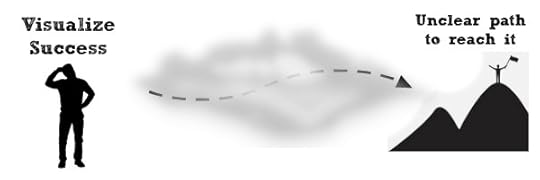
You may visualize yourself in possession of wealth, achievement, or whatever goal you are working toward, but if you don’t know the path from where you are to where you want to be, it will simply create this same gap in your mind.
EVENT-SIMULATIONWhat you may think:
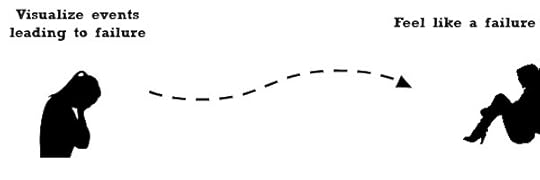
So why is event-simulation better at filling this gap? How is it possible to find the right path to success by visualizing your previous path to failure?
To answer these questions, let's see how event-simulation works in practice.
Imagine that you have been struggling to create an exercise habit for a long time. No matter how hard you try, you always end up procrastinating your trip to the gym...then another...then another...and eventually you give it up altogether.
See what happens when you use event-simulation in this situation:
Visualize your first thoughts of skipping the gym. Go over in detail everything that lead to you feeling that way.Visualize each step since. What happened from your initial thoughts to your eventual procrastination? What about the second or third skipped trips?Visualize the actions you took. Remember what you thought, said, and did at each step.Visualize the environment you were in. Where were you, who was around you, what did they say?Going through this exercise allows you to see the problem with a new perspective. You can understand the process you go through from your initial motivation to procrastinate, to eventually saying, “I’ll go tomorrow.” And then confronting the fact that you probably skipped that trip too.
At each step, you would have also seen how other factors throughout the day affected your ultimate decision. Factors which you may be able to avoid next time.
I forgot to bring my gym bag to work...next time I will get it ready the night before.
I ate an unhealthy lunch that made me feel tired...next time, I will pack a healthy lunch.
I was stressed from a long day of work...next time, I will see if the morning works better.
Not that any of these will magically change things, but added together they might be just enough to help you make the right decisions.
Reality:
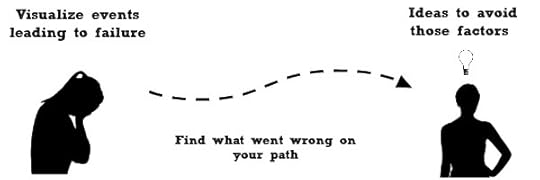
Compare this practice with visualizing that you have the body of a pro athlete or a swimsuit model…Is it any wonder that event-simulation is more effective?
CREATING A PLANWhat you may think:
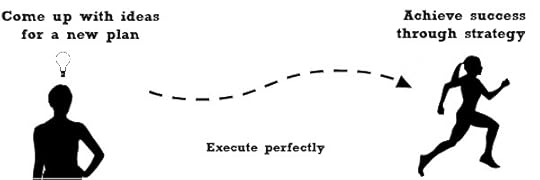
Okay, but what about planning?
The first problem with planning is that it normally doesn't take an account of the past. We focus on finding a new strategy, rather than finding out why the last one failed.
So, we try endless "8-week abs programs" and never become aware of the unpacked gym bag, unhealthy lunch, or failed attempts at evening workouts.
The next problem is that, as humans, we are overly optimistic about our abilities to execute our plans (why procrastination is a universal problem).
On Sunday night, we believe we will have all the willpower in the world to go to the gym on Wednesday evening—forgetting how exhausted we felt last Wednesday evening. [3]
Reality:

Event-simulation helps prevent that issue by forcing us to do what is known as a "reference class forecast." It helps us assess the reality of the past, like remembering how tired we were last Wednesday evening, and account for the factors that led to failing our last goal.
This helps immensely in setting a clearer path for the future. [4]
FOLLOWING a Proven PATHOkay, but what about reaching success with a completely new strategy? If you can't simulate your own events, how do you find the right path?
Back my story from the beginning, in addition to my attempts at visualizing success, I also started reading the top books and biographies of some of my greatest heroes in athletics, business, and creative fields.
As this site thoroughly demonstrates, these stories struck a chord with me that visualizing success didn’t—and there is solid evidence why.
When researchers study the brains of people reading a story, they find a similar pattern as when doing an event-simulation. We visualize each step of their story unfolding in our own minds to understand how the person reached success for failure.
As we visualize ourselves in their shoes, we naturally apply relevant steps to our own path. [5]
The best example of the power of this phenomenon is when Arnold Schwarzenegger read the story of Reg Park. He learned how Park started from humble beginnings, built himself into a bodybuilding champion, and then became a movie star. [6]
Sound familiar?
This story helped Arnold face relentless criticism from friends and family without giving up on his dream. Arnold had confidence because the path to achieving his dream was already set by Park—he just needed to follow it. [7]
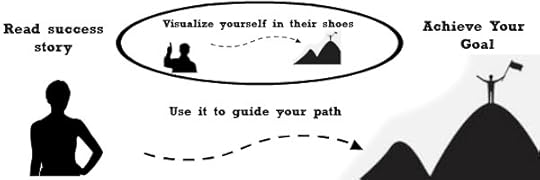
The best method for finding a path to success you've never reached, is to follow the path of those who have already achieved it.
conclusionVisualization is a powerful tool for reaching your goals. But visualizing the results, without knowing the process to achieve it, might just leave you frustrated by the gap between where you are and where your mind believes you should be.
A far more effective strategy is to visualize your failed attempts of the past to determine the factors that led you off your path. With that awareness, you can make effective changes to increase your chances of success.
Then when you're ready to go to the next level, learn the story of someone who has already reached it. When you learn the path someone has already taken to achieve your goal, you will naturally visualize yourself in their shoes.
And even if you can't take every step they did, at least you know the way to the top.
It will show you the specific steps each hero took to become a master in his or her field through:
12 videos sharing the path of each Hero and explaining how to implement their strategies.
Step-by-step guides showing the path to mastery in health, business, and creative fields.
Expert interviews with masters in each of the fields above sharing their paths to mastery.
And, of course, The Will of Heroes book itself.
If you're interested, the course launches on June 6th and you can click here to learn more.



